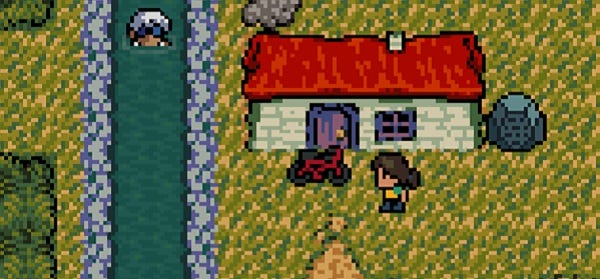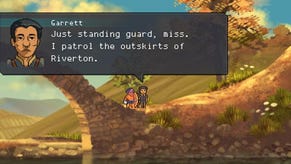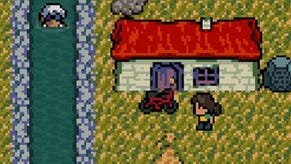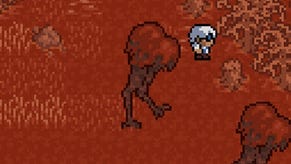Wot I Think: Anodyne
Fisherman's Friend
Anodyne's blend of surreal images and retro graphics appealed to me when I saw the first trailer but I only managed to find time to play through the game this weekend. I'm glad I did. It's an amusing, confusing, disturbing, perturbing action adventure that owes as much to Earthbound as to the Legend of Zelda, and almost as much to Silent Hill and Luis Buñuel. Here's wot I think.
Anodyne isn’t from the same mind as Lone Survivor but the creators may well have attended the same school of thought. Both games are steeped in aesthetics that at first seem to be drawn from memory but while Jasper Byrne’s survival horror adventure defies nostalgia, Anodyne is a window onto the past. Far more than the reskinned surreal and creepy Legend of Zeld-alike that the trailers strongly imply, it’s an emotionally divergent coming of age story that takes Nintendo’s early 2d arcade RPGs as its blueprint, puzzles and all, while ignoring the common elements of fantasy questing.
Despite some preliminary guff about saving the world, which is book-ended by quips that demonstrate the writer’s awareness that the characters are parping nonsense out of their face-holes, Anodyne is a personal story rather than a fariytale or heroic epic. The player character, Young, visits temples, mystical forests and impossible cliffs, but the most fascinating moments embrace the mystery of the mundane. An abandoned hotel in an unusual location. An accident prone circus. A grayscale suburb haunted by murder and fears of an empty future.
It’s a game filled with odd sights and even odder monologues, but the story it tells is personal. It’s about life and trying to live it, and it’s also about the games it resembles. Oh crap, you might be thinking, that sounds more self-important than a Colonel at a wake, but, thankfully, Anodyne isn’t a high-minded, lofty lecture of a game and nor is it a collection of poetic scribblings with an animated backdrop. There are loads of enemies to swat and dungeons to discover. There's an overworld to explore and enough variety in the one-room puzzles to provide satisfaction through the six or seven hours of playtime.
Leaving the moods and music to one side for a moment, the puzzles are the heart of the game. Combat is a constant, with most of the screens that make up the large, connected world containing at least one enemy. They range from blobs of slime that shuffle aimlessly, waiting to be put down, to fire-breathing circus lions and scampering acrobats with twisted bones. Although they all have their own behaviours, they are often distinguished by their appearance and the number of broom-swipes that they can take before dying rather than an underlying intelligence.
As the game progresses, the enemies cease to be obstacles in their own right and frequently become part of a room’s puzzle. At first, the goals are simple, often requiring little more than the death of every living thing before a door will unlock, but when the game introduces rats and roaches that must be chased onto or drawn toward switches in order to progress, advancing becomes more challenging. A map fills out at the top of screen, showing which rooms have possible exits and in which direction, and consulting it will generally reveal several paths to explore. If you do find yourself in a frustrating dungeon or area, the menu allows an immediate return to the entrance, or to the nexus, an in-between sort of place from which every area already visited can be accessed immediately.
While Anodyne isn’t a sixty hour epic, the world can seem sprawling, particularly when the first half is complete and the geography extends into weirder places, the connections and walkways more hazardous and tentative. It’s at this stage that I felt a deep appreciation for the nexus, the maps and the game’s simple but effective tracking of collectibles. Without those features, I’d have been lost and irritated, backtracking and killing the same respawning dogs again and again. The desire to see new places, and the horrors, sorrows and joys that they contain is such a driving force that it would have been awful to become bored by the weird. It’s always awful when the weird becomes boring, like walking around an art gallery and politely stroking your chin in front of a four hundred year old masterpiece, or shrugging as Guernica shrieks and strobes out of the canvas.
I didn’t spend a lot of time shrugging when I played Anodyne. I actually gasped once, the result of a pleasurable shock to the system as some of the shadows that creep around the borders of Anodyne’s world took centre stage. Even at its most grisly and unsettling, there’s a giggling black humour in the writing, which sometimes turns into an angry barking laughter. The details in the design of each area, particularly the more recognisable modern buildings, provide the relatively simple graphical style with a great deal of mileage. It would be remiss not to mention the superb soundtrack, which sounds as technically dated as the graphics look, but skips through genres with envious ease and summons all manner of atmospheres and emotions.
If the combat had been more varied, with more extensions to the broom and maybe even a suitably sweeping powered up attack, I’d probably have played more of the post-game, which cleverly reinterprets the player’s ability to explore the world. As it is, while the weapon is a fitting sword-substitute – read into it what you will – and integrates into puzzles and navigation well with its dust-gathering abilities, later enemies tend to be tougher or faster rather than trickier. That’s less of a complaint and more of an observation though, because the cleverest parts of the game use enemies as distractions and puzzle elements rather than direct opponents.
There’s a bitterness alongside the glimpses of something sweeter and the cards that Young collects on his journey, containing the thoughts and words of enemies and NPCs, cut more often than they soothe. It’s the quiet that will linger in my mind though – meeting the only friendly dog in the world, watching a sleeping city from a rooftop, failing to talk to a fisherman.
Remembering the fisherman makes me consider the whole game again. Perhaps my interpretation of Young's journey is too benign and it’d certainly be possible to find an entirely different story in the stitched together sentences and scenarios. The ambiguity is a strength rather than a misty vagueness. And, besides, it’d also be possible to enjoy hitting bats with a broom and solving puzzles in dungeons without worrying about anything else because, for all of its diversions and narrative mazes, Anodyne is also a refreshingly well-designed top-down adventure.
Anodyne is available now, direct from the developers, for $9. That'll secure you a Steam key too.



















